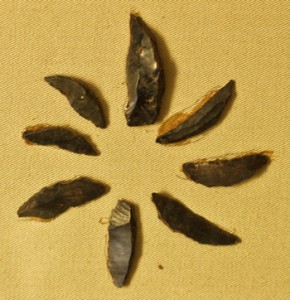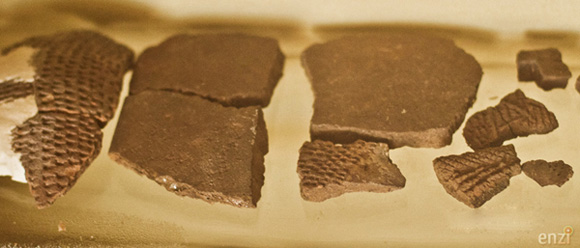Pre-Pottery & Pottery cultures
By Maina Kiarie
Pottery serves as an archaeological record of the span of human settlement. In its forms and decorations archaeologists can trace histories over time echoing changing populations and changing ways of life.

Small stone tool crescents made from Obsidian from Hyrax Hill
Before the development of pottery in East Africa, stone tools had undergone much refinement. The use of microliths (small stone tools made of flint, obsidian or chert and typically a centimetre or so in length and half a centimetre wide) and retouched implements was in use by the nomadic and semi-nomadic hunter gatherer communities, some of who lived in rock shelters.
The term “Wilton culture” has been in the past used to describe most of the non-ceramic (pottery) lithic (stone tool) traditions of sub-Saharan Africa.
In time there was development towards more specialised hunting and gathering and certain cultures concentrated into utilizing specific resources. This lead for example to specialised fishing and plant food gathering populations in the Nilo- Saharan-Sahelian zone and in eastern Africa at least in the Lake Turkana area about 10,000-8000 years ago. In areas such as Lowasera and Lothagam people fished for Tilapia using barbed bone points at sites dated to 7,000 to 6,000 years ago.
Pottery finds in the shores of Lake Victoria in western Kenya and surrounding areas such as Wadh Lang’o, Siror and Gogo Falls, are evidence that such specialised hunting and gathering led to the development of highly decorated ceramics known as Kansyore (or Oltome) pottery. The making and use of Kansyore pottery spans 8,000 – 3,000 years ago. The Kansyore tradition is associated with a relatively intensive lacustrine-based (related to lakes) subsistence pattern and relatively intense occupations.
There is National Museums of Kenya prehistoric site at Hyrax Hill, Nakuru, dated to 5,000 years ago.
In time there was the domestication of plants and animals. In East Africa earliest dated evidence of this comes from about 4500 years old layers in the northern highlands of Ethiopia.

Pottery shards from Hyrax Hill, Nakuru.
Further south in the Lake Turkana area, the first signs of domestication there are connected to Nderit pottery tradition about 4,500 years ago. Early Neolithic population in that area had contacts fruther south, which is attested by the obsidian finds that derive from the central Kenyan Rift Valley. The first signs of domestication south of Lake Turkana come from the Pastoral Neolithic (PN) communities the Central Rift area about 3,000 years ago, around the Lakes Naivasha, Nakuru and Elmenteita and Mau hills.
Kansyore pottery culture: 8,000 – 3,000 years ago
Pottery finds in the shores of Lake Victoria in western Kenya and surrounding areas such as Wadh Lang’o, Siror and Gogo Falls, are evidence that such specialised hunting and gathering led to the development of highly decorated ceramics known as Kansyore (or Oltome) pottery.
The making and use of Kansyore pottery spans 8,000 – 3,000 years ago. The Kansyore tradition is associated with a relatively intensive lacustrine-based (related to lakes) subsistence pattern and relatively intense occupations.
Nderit pottery culture: 4,000 – 1,500 years ago
Excavations in Central Rift Valley and surrounding highlands as well as in Lake Victoria, Gogo Falls & Wadh Lang’o revealed a pottery manufacturing style called Nderit ware and attributed the pastoral neolithic communities resident in the savannah. Nderit pottery is round bottom and decorated with incisions and stamps. Other artefacts found at the sites include microliths (small finely worked stone tools), stone bowls, pestle rubbers, polished stone “axes” and ostrich eggshell beads. There is evidence of domesticated animals and evidence of hunting at Nderit sites.
The Nderit cultures buried their dead in pits under small stone cairns. Other pottery traditions of the same period such as Akira ware and Narosura ware categorised as Oldishi tradition. Other studies have connected Maringishu & Nderit ware and called them Olmalenge ware. A National Museums of Kenya rock shelter in Kakapel, Amagoro, Western Kenya has pottery shards and rock paintings dated 4,000 years ago.
Elmenteitan pottery culture: 3,000 – 1,000 years ago
Elmenteitan pottery is relatively stereotypical, round bottomed, undecorated or with occasional depressions along the rim, and many times with spouts and lugs. The tradition first appeared in the Highlands west of the Rift Valley, and ater spread to Lake Victoria. Elementeitan pottery is found both in the small rock-shelters as well as at large open sites. There is no direct evidence of agriculture from early Elmenteitan sites, but the isotopic studies of skeletal remains suggest that some grain was consumed.
Stone tools at Elmenteitan sites is distinctive including microliths, long, utilised and segmented blades and burins plan (stone flake with a chisel-like edge which prehistoric humans may have used for engraving or for carving wood or bone), and is almost exclusively made out of obsidian. Elementeitan people cremated their dead. A later Elementeitan pottery style called Lanet ware (Pastoral Iron Age, 800 – 200 years ago) is decorated with twisting string roulette. Has been found in the Sirikwa Holes, e.g. Hyrax Hill (Nakuru), Central Rift and Western highlands. These food-producers had a strong indigenous tradition by the time Bantu-immigrants were approaching the area. In some areas this seems to have slowed down the migrations or directed them to other directions.
Urewe industry: 2,200 years ago
The Urewe industry is one of the earliest ceramic traditions in East Africa defined to the Early Iron Age (EIA) introduced by migrating Bantu speakers from Central Africa.
At sites like Gogo Falls and Wadh Lang’o, Urewe & Elementaitan cultures are seen to have coexisted. The EIA developed into the Middle Iron Age and Later Iron Age as seen towards Southern Africa.
Kwale pottery culture: 1,900 – 100 years ago
Migrating Early Iron Age populations of the eastern stream who had reached southern Kenya and North Tanzanian coast by 1,900 years go.


